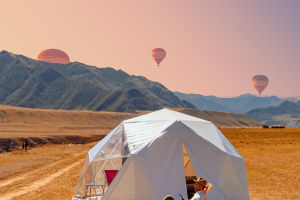Desert Travel
Embarking on a journey into the vastness of the desert demands meticulous preparation and a keen understanding of the challenges that come with such an environment.
Prioritizing water, safety, and ecological responsibility can make your desert adventure not only thrilling but also safe and sustainable. Here are some crucial precautions and tips to enhance your desert travel experience.
1. Hydration is Key:
Water is the lifeline of any desert adventure. Ensure you carry an ample supply of fresh water before venturing into the arid landscape. The desert's extreme conditions accelerate the body's water loss through evaporation, emphasizing the need for continuous hydration. However, it's crucial to strike a balance—excessive water intake without replenishing electrolytes can lead to water intoxication. Include salty snacks or electrolyte supplements in your provisions to maintain a healthy balance.
2. Safe Off-Road Travel:
For those exploring the desert in off-road vehicles, safety should be a top priority. Fasten your seat belt securely, grip the handrails tightly, and focus on the road ahead. It's imperative to follow the safety instructions provided by your driver. Individuals with severe heart conditions or high blood pressure should reconsider entering the desert, prioritizing their health over the thrill of the adventure.
3. Weather-Appropriate Attire:
Desert climates vary, and proper attire is essential for comfort and protection. In regions prone to sandstorms, opt for long-sleeved, sweat-absorbing clothing. During scorching summer days, sunscreen, lip balm, sunglasses, and a sunhat become indispensable. As the temperature drops rapidly at night, carry additional clothing in autumn to guard against catching a cold.
4. Footwear Matters:
Choose light, breathable suede shoes to prevent sand from entering and hindering your progress. Avoid walking during the scorching noon hours in summer, as the desert's surface temperature can lead to heatstroke and sunburn.
5. Health Essentials:
Prepare a medical kit with essentials like eye drops, antibacterial and anti-inflammatory drugs, motion sickness medicine, cold medicine, and remedies for gastrointestinal discomfort. After consuming fruits, avoid hot tea to prevent potential digestive issues.
6. Capture the Beauty:
Embrace the breathtaking moments of sunrise and sunset in the desert by having your camera and video equipment ready. Safeguard your gear when not in use to prevent sand particles from causing damage.
7. Respect the Ecosystem:
Contribute to the preservation of the delicate desert ecology by refraining from damaging plants and conserving water. These elements play a crucial role in maintaining the balance of the desert ecosystem.
8. Hiking Preparedness:
For desert hikes, equip yourself with proper camping gear and tools. Consider seeking assistance from professionals to set up tents and maintain open communication with your guide throughout the journey.
9. Ideal Seasons for Desert Travel:
Plan your desert adventure between mid-April and late October for optimal conditions. If you're into hiking and exploration, the prime season is from September to October.
10. Sandstorm Safety:
In the event of a sandstorm, avoid seeking shelter on the leeward slope of dunes, as it poses a risk of suffocation or burial. Stay vigilant and take necessary precautions to navigate through this natural phenomenon.
Embarking on a desert adventure requires a comprehensive approach, encompassing safety, environmental responsibility, and thoughtful planning. By adhering to these precautions and tips, you can ensure a fulfilling and secure experience in the enchanting landscapes of the desert.


